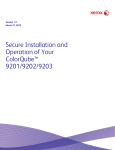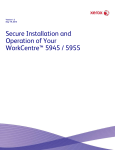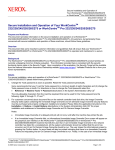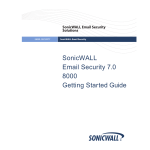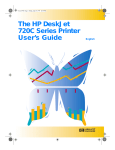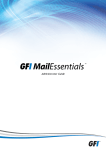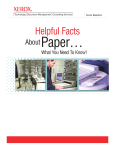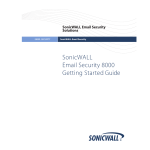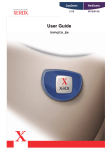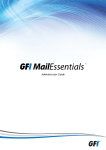Download Secure Installation and Operation of Your WorkCentre 5632
Transcript
Version 1.8
Jul 30, 2010
Secure Installation and
Operation of Your
WorkCentre™
5632/5638/5645/5655/
5665/5675/5687
Secure Installation and Operation of Your WorkCentre™
5632/5638/5645/5655/5665/5675/5687
Purpose and Audience
This document provides information on the secure installation and operation of a WorkCentre™
5632/5638/5645/5655/5665/5675/5687 Multifunction System. All customers, but particularly those concerned with secure
installation and operation of these machines, should follow these guidelines.
Overview
This document lists some important customer information and guidelines that will ensure that your WorkCentre™
5632/5638/5645/5655/5665/5675/5687 Multifunction System is operated and maintained in a secure manner.
Background
The WorkCentre™ 5632/5638/5645/5655/5665/5675/5687 Multifunction System is currently undergoing Common Criteria
evaluation. The information provided here is consistent with the security functional claims made in the Security Target. Upon
completion of the evaluation, the Security Target will be available from the Common Criteria Certified Product website
(http://www.commoncriteriaportal.org/products.html) list of evaluated products or from your Xerox representative.
Secure Evaluated Configuration Installation, Setup and Operation
Please follow the guidelines below for secure installation, setup and operation of the evaluated configuration for a
WorkCentre™ 5632/5638/5645/5655/5665/5675/5687 Multifunction System:
1.
The security functions in the evaluated configuration of the WorkCentre™ 5632/5638/5645/5655/5665/5675/5687 that should
be set up by the System Administrator are:
• Immediate Image Overwrite
• On Demand Image Overwrite
• Disk Encryption
• IP Filtering
• Audit Log
• SSL (for protection of management data)
• Trusted Certificate Authorities
• Authentication and Authorization
Follow the instructions located on the SA CD 1 in the Reference Æ Security tabs/buttons to set up these security functions
except as noted in the items below.
2.
The following services of the WorkCentre™ 5632/5638/5645/5655/5665/5675/5687 are also considered part of the evaluated
configuration and should be enabled when needed by the System Administrator - Copy, Embedded Fax, Scan to E-mail, Network
Scanning, Saved Jobs for Reprint, Reprint Saved Jobs, and ID Card Copy.
3.
Secure acceptance of the WorkCentre™ 5632/5638/5645/5655/5665/5675/5687, once device delivery and installation is
completed, should be done by:
• Printing out a Configuration Report by following the instructions located on the SA CD1 in the Reference Æ Reports Æ
Configuration tabs..
• Comparing the software/firmware versions listed on the Configuration Report with the Evaluated Software/Firmware
versions listed in Table 2 of the Xerox WorkCentre™ 5632/5638/5645/5655/5665/5675/5687 Multifunction Systems
Security Target, Version 1.0 and make sure that they are the same in all cases.
4.
Follow the instructions located on the SA CD1 in the Reference Æ Security Æ Authentication and Authorization Æ
Authentication Configuration tabs/buttons to set up an Authentication Server. Follow the instructions located on the SA CD1 in
the Reference Æ Security Æ Authentication and Authorization Æ Xerox Common Access Card tabs/buttons to set up user
authentication via a Common Access Card.
5.
For customers concerned about document files on the network controller hard disk drive or Embedded Fax card memory, the
Image Overwrite Security (IOS) option containing the Immediate Image Overwrite and On Demand Image Overwrite security
features, which comes installed on the WorkCentre™ 5632/5638/5645/5655/5665/5675/5687 Multifunction System, must be
properly configured and enabled. Please follow the applicable instructions in the Reference Æ Security Æ Image Overwrite
Security tabs/buttons in the System Administration (SA) CD1 for proper enablement of Immediate Image Overwrite and On
Demand Image Overwrite.
TP
1
(WorkCentre™ 5632/5638/5645/5655/5665/5675/5687) System Administration CD1, 538E11432
Notes:
•
Immediate Image Overwrite of a delayed print job will not occur until after the machine has printed the job.
•
If an Immediate Image Overwrite fails, an informational Immediate Image Overwrite Error screen will likely appear on the
graphical user interface on the WorkCentre™ 5632/5638/5645/5655/5665/5675/5687 Multifunction System that tells the
user that (1) an Immediate Image Overwrite has failed for a completed job, (2) the system administrator should be notified
that this error has occurred, and (3) an On Demand Image Overwrite should be run. The user closes this informational
screen by pressing the Confirm button. An error sheet, when enabled, will always be printed indicating that there is an
Immediate Overwrite Failure and requesting that an On Demand Image Overwrite be run. Finally, in the case of an
Immediate Image Overwrite failure while processing a print job, an error message will appear at the top of this screen
indicating that an On Demand Image Overwrite should be run.
•
If there is a power failure or system crash while a network scan job is being processed, an Immediate Overwrite of the
residual data will occur upon job recovery. However, the network scan job may not appear in the Completed Job Log.
•
If there is a power failure or system crash of the network controller while processing a print job, residual data might still
reside on the Network Controller hard drive. The System Administrator should immediately invoke an On Demand Image
Overwrite once the machine has been restored.
•
Two forms of On Demand Image Overwrite are manually invoked – a Standard On Demand Image Overwrite that will
overwrite all image data except data stored by the Save Job for Reprint feature and data stored in Embedded Fax dial
directories and mailboxes and a Full On Demand Image Overwrite that will overwrite all image data including data stored
by the Save Job for Reprint feature and data stored in Embedded Fax dial directories and mailboxes. Follow the instructions
in the Installation Æ Security Æ Image Overwrite Security Æ On Demand Image Overwrite tabs/buttons in the SA CD1
for invoking a Standard of Full On Demand Image Overwrite from either the Local User Interface (Local UI) or the Web User
Interface (WebUI).
The System Administrator also has the option of scheduling either a Standard or Full On Demand Image Overwrite from the
WebUI. Follow the instructions in the Reference Æ Security Æ Image Overwrite Security Æ On Demand Image
Overwrite Æ Auto Schedule an Overwrite tabs/buttons in the SA CD1 to schedule an On Demand Image Overwrite.
•
Before invoking an On Demand Image Overwrite verify that:
• There are no active or pending print or scan jobs.
• There are no new or unaccounted for Dynamic Loadable Modules (DLMs) or other software running on the machine.
• There are no active processes that access the network controller hard disk.
• No user is logged into a session via telnet, network accounting, Xerox Standard Accounting, or the internal auditron, or
into a session accessing a directory on the network controller hard disk.
• After a power on of the machine all subsystems must be properly synced and, if printing of Configuration Reports is
enabled on the device, the Configuration Report must have printed.
• For any previously initiated On Demand Image Overwrite request the confirmation sheet must have printed.
• The Embedded Fax card must have the correct software version and must be properly configured.
•
When invoked from the Web UI the status of the completed On Demand Image Overwrite will not appear on the Local UI
but can be ascertained from the On Demand Overwrite Confirmation Report that is printed after the Network Controller
reboots.
•
If a System Administrator aborts an On Demand Image Overwrite, Xerox recommends that the machine be allowed to
complete its system reboot before a Software Reset is attempted from the Tools Pathway via the Local User Interface.
Otherwise, the Local UI will become unavailable. The machine will have to be powered off and then powered on again to
allow the system to properly resynchronize.
•
The System Administrator may cancel an On Demand Image Overwrite only at the Local UI if it was initiated at that
interface. If an On Demand Image Overwrite was initiated from the WebUI, it cannot be aborted from either the WebUI or
Local UI.
•
If there is a failure in the network controller hard disk a message recommending that an On Demand Image Overwrite be
run will appear on the Local UI screen. An Immediate Image Overwrite Error Sheet will also be printed or may contain
incomplete status information. The System Administrator should immediately perform the requested On Demand Image
Overwrite.
•
If an On Demand Image Overwrite is successfully completed, the completion (finish) time shown on the printed On Demand
Overwrite Confirmation Report will be the time that the system shuts down.
2
•
If an On Demand Image Overwrite fails to complete because of an error or system crash, Xerox recommends that the
System Administrator immediately perform another On Demand Image Overwrite, but only after completion of a system
reboot or software reset initiated from the Local User Interface or the Web User Interface.
•
The System Administrator should perform an On Demand Image Overwrite immediately before a WorkCentre™
5632/5638/5645/5655/5665/5675/5687 Multifunction System is decommissioned, returned, sold or disposed of.
6.
The WorkCentre™ 5632/5638/5645/5655/5665/5675/5687 Multifunction System supports the use of SSLv2.0, SSLv3.0, RC4 and
MD5. However, customers are advised to set the cyrpto policy of their clients to request either SSLv3.1 or TLSv1.0 and to disallow
the use of RC4 and MD5.
7.
For SSL to work properly the machine must be assigned a valid, fully qualified machine name and domain. To set the machine
name and domain:
8.
9.
•
At the Web UI, select the Properties tab.
•
•
Select the following entries from the Properties 'Content menu’: Connectivity Æ Protocols Æ IP.(Internet Protocol)
Enter the domain name in the ‘Domain Name’ text box inside the Domain Name group box; enter the machine name in
the ‘Host Name’ text box inside the General group box.
Xerox recommends the following when utilizing Secure Sockets Layer (SSL) on a WorkCentre™
5632/5638/5645/5655/5665/5675/5687:
•
Any self-signed digital certificate or digital certificate signed by a Trusted Certificate Authority should have a maximum
validity of 180 days.
•
If a self-signed certificate is to be used the generic Xerox root CA certificate should be downloaded from the device and
installed in the certificate store of the user's browser.
To enable HTTPS (SSL):
•
At the Web UI, select the Properties tab.
•
•
Select the following entries from the Properties 'Content menu’: Connectivity Æ Protocols Æ HTTP.
Select the Secure HTTP (SSL) Enabled checkbox in the Configuration group box and enter the desired HTTPS port number
in the Port Number text box.
•
Select the [Apply] button. This will save the indicated settings. After saving the changes the HTTP page will be redisplayed.
10. In viewing the Audit Log the System Administrator should note the following:
•
Submittal or deletion of copy and embedded fax jobs are not recorded in the Audit Log.
•
Deletion of a file from a Saved Job for Reprint folders or deletion of a Saved Job for Reprint folder itself is recorded in the
Audit Log.
•
Deletion of a print or scan job or deletion of a scan-to-mailbox job from its scan-to-mailbox folder may not be recorded in
the Audit Log.
11. Be careful not to create an IP Filtering rule that rejects incoming TCP traffic from all addresses with source port set to 80; this
will disable the Web UI. Note: IP Filtering is available only with IPv4, and is not available for either the AppleTalk protocol or the
Novell protocol with the ‘IPX’ filing transport.
12. To enable disk encryption:
•
At the Web UI, select the Properties tab.
•
•
Select the following entries from the Properties 'Content menu’: Security Æ User Data Encryption.
Select the Enabled checkbox in the User Data Encryption Enablement group box.
•
Select the [Apply] button. This will save the indicated setting. After saving the changes the User Data Encryption page will
be redisplayed.
Xerox recommends that before enabling disk encryption the System Administrator should make sure that the WorkCentre™
5632/5638/5645/5655/5665/5675/5687 is not in diagnostics mode and that there are no active or pending scan jobs.
13. The System Administrator should ensure that the Embedded Fax Card and fax software is installed in accordance with the
instructions in the Installation Æ Services Æ Embedded Fax Æ Complete the Fax Install Screens and Fax Setup tabs in the
SA CD1. The System Administrator can then set Embedded Fax parameters and options via the Local User Interface on the
machine. Follow the instructions in the Tutorials Æ Machine Administration Æ Tools Pathway Æ Fax Setups tabs in the
Interactive User Guide 2 .
2
(WorkCentre™ 5632/5638/5645/5655/5665/5675/5687) Interactive User Guide CD2, 538E11443
3
14. If the Save Jobs for Reprint/Reprint Saved Jobs service is enabled the private folder authentication is not working properly. The
System Administrator should establish the appropriate policies and procedures to ensure that any jobs are saved only into either
the default public folder or a read-only public folder. Documents of a sensitive nature should not be stored on the device until
the issue is resolved.
15. Change the Tools password as soon as possible. Reset the Tools password periodically.
Xerox recommends that you (1) set the Tools password to a minimum length of eight alphanumeric characters, (2) change the
Tools password once a month and (3) ensure that all passwords are strong passwords (e.g., passwords use a combination of
alphanumeric and non-alphanumeric characters; passwords don’t use common names or phrases, etc.).
For directions on how to change the Tools password from the Local User Interface, select the:
• Reference Æ Security Æ Authentication and Authorization Æ Administrator Authentication tabs/buttons in the System
Administration (SA) CD1
For directions on how to change the Tools password from the Web User Interface, select the:
•
Reference Æ Security Æ Authentication and Authorization Æ Authentication Configuration Æ Device System
Administrator Password tabs/buttons in the System Administration (SA) CD1
Additional Secure Configuration Installation, Setup and Operation Guidelines
1.
2.
Xerox recommends the following when utilizing Secure Sockets Layer (SSL) for secure scanning on a WorkCentre™
5632/5638/5645/5655/5665/5675/5687:
•
SSL should be enabled and used for secure transmission of scan jobs from a WorkCentre™
5632/5638/5645/5655/5665/5675/5687.
•
When storing scanned images to a remote repository using an https: connection, a Trusted Certificate Authority certificate
should be uploaded to the device so the device can verify the certificate provided by the remote repository.
•
When an SSL certificate for a remote SSL repository fails its validation checks the associated scan job will be deleted and
not transferred to the remote SSL repository. The System Administrator should be aware that in this case the job status
reported in the Completed Job Log for this job will read: “Job could not be sent as a connection to the server could not be
established”.
If the use of SNMPv3 is desired, it can be set up by following these instructions:
SNMPv3 cannot be enabled until SSL (Secure Sockets Layer) and HTTPS (SSL) are enabled on the machine.
•
•
•
•
•
At the WebUI, select the Properties tab.
Select the following entries from the Properties 'Content menu’: Connectivity Æ Protocols Æ SNMP. This will display the
SNMP Configuration page.
Select the Enable SNMP v3 Protocol checkbox inside the SNMP Properties group box.
Select the Edit SNMP v3 Properties button inside the SNMP Properties group box. This will cause the Edit SNMP v3 Properties
page to be displayed.
On the Edit SNMP v3 Properties page:
•
Select the Account Enabled button inside the Administrator Account group box to create an administrator account.
•
Enter the desired Username and Authentication Password. The Authentication Password must be at least 8
alphanumeric characters.
•
Enter the desired Privacy Password of at least 8 alphanumeric characters.
•
Select the Account Enabled button inside the Print Drivers Account group box to create an account for bi-directional
print drivers / Xerox remote clients.
•
Select the [Apply] button. This will create an administrator account and save the indicated settings/passwords. After
saving the changes the SNMP Configuration page will be redisplayed.
Once SNMPv3 is enabled, SSL can be disabled and SNMPv3 will still function properly.
3.
Xerox recommends that the System Administrator change the SNMP v1/v2c public/private community strings from their default
string names to random string names.
4.
Xerox strongly recommends that IPSec should be used for secure printing only; HTTPS (SSL) should be used to secure scanning.
Note: IPSec is not available for either the AppleTalk protocol or the Novell protocol with the ‘IPX’ filing transport. IPSec also
does not protect the IPv6 protocol. .
4
5.
Before upgrading software on a WorkCentre™ 5632/5638/5645/5655/5665/5675/5687 Multifunction System via the
Manual/Automatic Customer Software Upgrade, please check for the latest certified software versions. Otherwise, the machine
may not remain in its certified configuration. To maintain the certified configuration, it is recommended that acceptance of
customer software upgrades via the network be turned off/disabled on both the Local UI (Customer Software Upgrade screen)
and the Web UI (Upgrade web page).
6.
Xerox recommends that customers sign up for the RSS 3 subscription service available only via the Xerox Security Web Site
(Security@Xerox) at www.xerox.com/security that permits customers to view the latest Xerox Product Security Information and
receive timely reporting of security information about Xerox products, including the latest security patches that apply to the
WorkCentre™ 5632/5638/5645/5655/5665/5675/5687 Multifunction System.
7.
The WorkCentre™ 5632/5638/5645/5655/5665/5675/5687 Multifunction System should be installed in a standard office
environment. Office personnel should be made aware of authorized service calls (for example through appropriate signage) in
order to discourage unauthorized physical attacks such as attempts to remove the internal hard disk.
8.
Xerox recommends that the system administrator continuously monitor the network that the WorkCentre™
5632/5638/5645/5655/5665/5675/5687 Multifunction System is connected to for unapproved activities and/or attempts to
attack network resources, including the device itself. This should include monitoring of the number of logon tries to the Web UI.
9.
Customers who encounter or suspect software problems against a WorkCentre™ 5632/5638/5645/5655/5665/5675/5687
Multifunction System should immediately contact the Xerox Customer Support Center to report the suspected problem and
initiate the SPAR (Software Problem Action Request) 4 process for addressing problems found by Xerox customers.
10. System Administrator login is required when accessing the security features of a WorkCentre™
5632/5638/5645/5655/5665/5675/5687 machine via the Web User Interface.
11. A reboot of the system software for a WorkCentre™ 5632/5638/5645/5655/5665/5675/5687 machine is necessary before a
change made to the System Administrator password from the Local User Interface will be synced with and accepted by the Web
User Interface. Until this system software reboot occurs, system administrator functions from the Web User Interface should not
be accessed.
12. Caution: A WorkCentre™ 5632/5638/5645/5655/5665/5675/5687 allows an authenticated System Administrator to disable
functions like Image Overwrite Security that are necessary for secure operation. System Administrators are advised to
periodically review the configuration of all installed machines in their environment to verify that the proper secure configuration
is maintained.
13. Depending upon the configuration of the WorkCentre™ 5632/5638/5645/5655/5665/5675/5687, two IPv4 addresses, a primary
IPv4 address and a secondary IPv4 address, may be utilized. The System Administrator assigns the primary IPv4 address either
statically or dynamically via DHCP from the IP (Internet Protocol)page on the Web UI 5 . The second IPv4 address is assigned
via APIPA when the System Administrator enables the ‘Self Assigned Address’ option from the IP (Internet Protocol)page on
the Web UI. If the ‘Self Assigned Address’ option is enabled (which is the default case), this secondary IPv4 address will not be
visible to the SA 6 . Xerox recommends that the ‘Self Assigned Address’ option from the Web UI IP (Internet Protocol) page be
disabled unless either APIPA is used or Apple Rendezvous/Bonjour support is required.
14. If a system interruption such as power loss occurs a job in process may not be fully written to the network controller hard disk.
In that case any temporary data created will be overwritten during job recovery but a corresponding record for the job may not
be recorded in the completed job log or audit log.
15. The following windows are available from the Local User Interface to a WorkCentre™ 5632/5638/5645/5655/5665/5675/5687
with System Administrator login and authentication. These windows provide standard system configuration or job management
capability:
•
User Feature Enablement Code - Allows ability to enter a valid User Feature Enablement Code to enable or disable specific
machine system configuration and service functions. Is accessible by selecting the ‘Enablement Code’ button from the
Authentication Login Required or Pathway Options screens.
3
RDF Site Summary, or Rich Site Summary, or Really Simple Syndication – A lightweight XML format for distributing news headlines and other
content on the Web. Details for signing up for this RSS Service are provided in the Security@Xerox RSS Subscription Service guide posted on the
Security@Xerox site at
http://www.xerox.com/go/xrx/template/009.jsp?view=Feature&ed_name=RSS_Security_at_Xerox&Xcntry=USA&Xlang=en_US.
4
A SPAR is the software problem report form used internally within Xerox to document customer-reported software problems found in products in
the field.
5
The primary IPv4 address can also be assigned dynamically via DHCP from the Dynamic Addressing screen on the Local UI.
6
The primary IPv4 address will always be displayed on the Configuration Report that can be printed for a WorkCentre™
5632/5638/5645/5655/5665/5675/5687.
5
•
USB Printer Port - Allows ability to enable/disable and set the configuration of the USB Printer Port connectivity. Is
accessible by selecting the following screens/buttons in order: Tools Mode Screen 1 of 3 screen Æ Connectivity and
Network Setup button Æ Direct Connection button Æ USB Printer Port button.
•
Parallel Port - Allows ability to enable/disable and set the configuration of parallel port printing. Is accessible by selecting
the following screens/buttons in order: Tools Mode Screen 1 of 3 screen Æ Connectivity and Network Setup button Æ
Direct Connection button Æ Parallel Port button. Note that this window is only available to WorkCentre™
5632/5638/5645/5655/5665/5675/5687 Multifunction Systems that have the Multi-Board Controller (MBC) hardware
configuration.
•
SA Delete Job – For jobs other than an Internet Fax job that do not require a Secure ID PIN but do require System
Administrator authentication (i.e., the System Administrator has set Job Operation rights to ‘System Administrator’ and the
job was not submitted as a Secure Print or Secure Fax job), allows the System Administrator to be authenticated as a valid
System Administrator and then delete the job. Is accessible by selecting the {Job Status} button on the machine, then
selecting a job from the displayed Job Queue and then selecting the ‘Delete’ button from the displayed Job Status Job
Monitor window.
•
Dual Authentication Delete Job – For jobs other than an Internet Fax job that require both a Secure ID PIN and System
Administrator authentication (i.e., the System Administrator has set Job Operation rights to ‘System Administrator’ and the
job was submitted as a Secure Print or Secure Fax job), allows the System Administrator to be authenticated as a valid
System Administrator and then delete the job. Is accessible by selecting the {Job Status} button on the machine, then
selecting a job from the displayed Job Queue and then selecting the ‘Delete’ button from the displayed Job Status Job
Monitor window.
16. The following windows are available from the Local User Interface to a WorkCentre™ 5632/5638/5645/5655/5665/5675/5687
with no System Administrator login and authentication required. These windows provide standard machine services or job
management capability:
•
Delete Job Confirmation – For jobs other than an Internet Fax job that do not require either a Secure ID PIN or System
Administrator authentication (i.e., the System Administrator has set Job Operation rights to ‘All Users’ and the job was not
submitted as a Secure Print or Secure Fax job), allows a user to confirm deletion of the job. Is accessible by selecting the
{Job Status} button on the machine, then selecting a job from the displayed Job Queue and then selecting the ‘Delete’
button from the displayed Job Status Job Monitor window.
•
Pausing an active job being processed by the device – Allows the user to pause an active copy, print, scan or Embedded
Fax job while it is being processed by the WorkCentre™ 5632/5638/5645/5655/5665/5675/5687. Is accessible by selecting
the ‘Stop’ machine hard button while a job is being processed by the device. Depending on the type of job being processed
by the device, one of the following Pause windows will be displayed as appropriate to allow the user to determine whether
to delete or continue processing of the job: Scanning Pause window, Printing Pause window, Scanning/Printing (Two
Jobs) Pause window, Resume Marking/Incomplete Scan Job Pause window, Marking/Scanning Job Pause window, Build
Job/No Marking Pause window, Build Job/ Marking Pause window, Build Job Sample Printing/ One Segment Scanned
Pause window or Build Job Sample Printing/More Than One Segment Scanned Pause window.
•
Pause to Unload Finisher Hard Button - Allows the user to remove output from a finisher’s Stacker Tray while preventing
the device from outputting marked sheets to the finisher at the same time. Is accessible by selecting the Pause to Unload
hard button on the finisher.
•
CPSR (Capture/Print, Save and Reprint) Information Pop-Up Screen – Provides error information and/or required actions
to the user after the user has exercised selected screens and buttons (e.g., creation and deletion of a folder or job) of the
‘Save Job for Reprint’ and ‘Reprint Saved Jobs’ Feature Pathways .on a WorkCentre™
5632/5638/5645/5655/5665/5675/5687. The CPSR Information pop-up screen will appear automatically when the proper
screens and/or buttons are selected by the user and will provide the user with the needed information or actions to
complete the desired ‘Save Job for Reprint’ and ‘Reprint Saved Jobs’ functions.
•
User Interface Diagnostics - Allows the user to run diagnostics on the User Interface software. Is accessible by pressing the
machine hard buttons ‘Dial Pause’ + ‘*’ + ‘#’ in that order.
•
Encryption/Decryption in Progress Pop-Up Screen – Informs the user that a WorkCentre™
5632/5638/5645/5655/5665/5675/5687 is performing an encryption or decryption of data stored on the Network
Controller hard disk. The Data Encryption/Decryption in progress pop-up screen will appear automatically whenever a
machine that is in an operational mode receives a request that requires data stored on the Network Controller hard disk to
be either encrypted or decrypted.
17. The following pages are available from the Web User Interface to the WorkCentre™ 5632/5638/5645/5655/5665/5675/5687
with System Administrator login and authentication. These pages provide additional system functional capability:
6
7
•
Reboot Machine – Provides ability to reboot the machine from the Internet. Is accessible from the Description & Alerts
page by selecting the Status tab and then selecting Descriptions and Alerts from the Status tab content menu.
•
Public Address Book – Allows the System Administrator to set up the contents and access rights for the Public Address Book.
Is accessible by selecting the Public Address Book tab. From the Public Address Book tab content menu the System
Administrator can access the following pages to setup the Public Address Book:
• View All Names – Displays the Public Address Book page and provides access to all names in the Public Address Book.
• Edit – Edits a Public Address Book name selected from the Public Address Book page.
• Add New Name – Accesses the Add New Name page to add a new name to the Public Address Book.
• Import – Accesses the Import page to import of names from a file that will be added to the Public Address Book. A
Next button on the Import page allows the System Administrator to set options on how the names are to be imported.
• Export – Accesses pages to export the Public Address Book to a user-defined file.
• Download Sample – Allows the System Administrator to download a sample Public Address Book into a user-defined
file where names can be added at a later time.
• Delete All Names – Allows the System Administrator to delete all names from the Public Address Book.
• Access Rights - Allows the System Administrator to set the access rights to the Public Address Book.
•
Web Services – Allows the System Administrator to set up various Web Services that utilize the HTTP protocol. Is accessible
by selecting the Properties tab and then selecting Connectivity Æ Protocols Æ HTTP Æ Web Services tab from the
Properties tab content menu.
•
NTP - Allows the System Administrator to set the device date and time using an external server. Is accessible by selecting
the Properties tab and then selecting Connectivity Æ Protocols Æ NTP from the Properties tab content menu.
•
FTP – Allows the System Administrator to set the parameters for the FTP protocol used in network filing. Is accessible by
selecting the Properties tab and then selecting Connectivity Æ Protocols Æ FTP from the Properties tab content menu.
•
WSD (Web Services for Devices) – Allows the System Administrator to enable Web Services on the device. Is accessible by
selecting the Properties tab and then selecting Connectivity Æ Protocols Æ WSD (Web Services for Devices) from the
Properties tab content menu.
•
E-mail Domain Filter – Allows the System Administrator to set how address books search domains for E-mail addresses. Is
accessible by selecting the Properties tab and then selecting Services Æ E-mail Æ Domain Filter from the Properties tab
content menu.
•
Web Services Advanced Settings – Allows the System Administrator to clear the Web Services IP Address Lockout cache. Is
accessible by either (1) selecting the Properties tab and then selecting Connectivity Æ Protocols Æ HTTP Æ Web Services
tab Æ Advanced Settings button from the Properties tab content menu or (2) by typing http://{IP
Address} 7 /diagnostics/ipLockout.php.
•
(Workflow Scanning) Display Settings – Allows the System Administrator to setup how the Workflow Scanning template
list is displayed on the Local UI. Is accessible by either (1) selecting the Properties tab and then selecting Services Æ
Workflow Scanning Æ Display Settings from the Properties tab content menu or (2) selecting the ‘Refer to Display
Settings for more template controls’ hyperlink from any of the scan and network scanning template pages.
•
Validation Options – Permits the System Administrator to allow the user name to be sent with the validation request if the
user is authenticated at the Local UI. Is accessible by selecting the Properties tab and then selecting Services Æ Custom
Services Æ Validation Options from the Properties tab content menu.
•
Fax Forward on Receive – Allows the System Administrator to enable forwarding of receive Embedded Faxes to alternate
destinations such as E-mail addresses or file repositories. Is accessible by selecting the Properties tab and then selecting
Services Æ Embedded Fax Æ Fax Forward from the Properties tab content menu. From the Fax Forward on Receive page
the System Administrator can access the following pages to setup Fax Forward on Receive:
• Edit – Displays the Rule page to set or modify the alternate destinations for a received Embedded Fax.
• Customize – Displays the Custom File Name or Custom Attachment Name page, depending on the type of alternate
destination, to customize the name of the file or attachment the received Embedded Fax will be stored in.
•
Authentication Configuration – CAC (Common Access Card) - Provides ability to set up the Domain Controller and other
elements needed to configure CAC authentication on a WorkCentre™ 5632/5638/5645/5655/5665/5675/5687. The main
Authentication Configuration > CAC/PIV Setup page is accessible by selecting the following entries from the Properties
'Content menu’: Security Æ Authentication Configuration Æ Edit or Configure (Device User Interface Authentication
Method) button (where [CAC/PIV] is the Device User Interface Authentication Method chosen on the Authentication
{IP Address} is the IPv4 address of the machine
7
Configuration Setup page); from that page the other pages needed to configure CAC are accessible. When configuring the
CAC domain controller the System Administrator should make sure that the Port Number entered is less than 65536.
•
System Timeout – Permits the System Administrator to set up a WebUI inactivity timer for the device. Is accessible by
selecting the Properties tab and then selecting Security Æ System Timeout from the Properties tab content menu.
•
Application Domain/Content Query - Allows the configuration of the system to perform an LDAP query for the logged-in
user’s authentication domain prior to authenticating the server. Is accessible by typing http://{IP
Address}8/diagnostics/index.dhtml and then selecting ‘Authentication Domain/Context Query’ from the Diagnostics
Content Menu.
•
Scanning Lock Files - Allows bypassing the filename locking feature. Is accessible by typing http://{IP
Address}9/diagnostics/index.dhtml and then selecting ‘Scanning Lock Files’ from the Diagnostics Content Menu or by
typing http://{IP Address}4/diagnostics/lockFiles.dhtml.
•
Secure Attribute Editor - Allows the user to change some system attributes related to PDLs (e.g., memory usage, copies per
page, etc.). Is accessible by typing http://{IP Address}9/diagnostics/secureattr.dhtml.
•
Suppress Job Name - Allows the System Administrator to suppress displaying the job name on the Banner Page when
submitting a print job. Is accessible by typing http://{IP Address}9/diagnostics/jobNameSuppress.dhtml.
•
Job Log File Format - Allows the System Administrator to set the XML job log file format. Is accessible by typing http://{IP
Address}9/diagnostics/jobLog.dhtml.
•
File Extension Case - Allows the System Administrator to select all file extensions to be created in either lower or upper
case. Is accessible by typing http://{IP Address}9/diagnostics/fileExtensionCase.dhtml.
•
Email Security - Allows the System Administrator to secure the device’s email service. Is accessible by typing http://{IP
Address}9/diagnostics/emailSecurity.php.
•
Binary Printing Support - Allows the device to accept printing jobs that are identified as binary files. Is accessible by typing
http://{IP Address}9/diagnostics/binaryAllow.php.
•
XSA Reports with User IDs - Allows the device to generate Xerox Standard Accounting reports with User IDs. Is accessible
by typing http://{IP Address}9/diagnostics/enableUserID.php.
•
Postscript Filter PDL Guessing Policy - Allows the System Administrator to select whether the Postscript Filter guess
algorithm will use a strict or loose interpretation. Is accessible by typing http://{IP
Address}9/diagnostics/postScriptTokens.php.
•
Service Registry Reset - Allows the System Administrator to reset the device’s Service Registry to its default values. Is
accessible by typing http://{IP Address}9/diagnostics/registryReset.php.
•
Job Queue Limit - Allows the System Administrator to set the maximum number of jobs that can be listed in the device’s
job queues. Is accessible by typing http://{IP Address}9/diagnostics/jobLimit.php.
•
DLM Maker - Allows the System Administrator to create a DLM out of any file. Is accessible by typing http://{IP
Address}9/diagnostics/dlmMaker.php.
•
Barcode Space Character Interpretation - Allows the System Administrator to choose how the device renders space
characters within barcode fonts. Is accessible by typing http://{IP Address}9/diagnostics/barcodeSpaceToggle.php.
•
DHCP v6 - Allows the System Administrator to choose which compliance option will be followed when DHCP v6 is used. Is
accessible by typing http://{IP Address}9/diagnostics/ dhcpv6Options.php.
•
View Service Registry Contents - Allows the System Administrator to view the contents of the device’s Service Registry. Is
accessible by typing http://{IP Address}9/diagnostics/viewRegistry.php.
•
Diagnostics Tree - Allows the System Administrator to view the selectable list of diagnostics Special Purpose Pages. Is
accessible by typing http://{IP Address}9/diagnostics/tree.php.
•
Color Copy Control Test Result - Allows the System Administrator to view the Color Copy Control test results. Is accessible
by typing http://{IP Address}9/diagnostics/testResult.php.
•
PCL Advanced Configuration - Allows the System Administrator to enter the desired PCL advanced configuration paper size
code. Is accessible by typing http://{IP Address}9/diagnostics/pclSetup.php.
•
Grey Other Queue Button - Allows the System Administrator to grey out the ‘Other Queue’ button on the Local UI. Is
accessible by typing http://{IP Address}9/diagnostics/hideotherqueuesbutton.php.
8
•
Download DLM PCL Forms - Allows the System Administrator to download the DLM PCL forms into the device. Is accessible
by typing http://{IP Address}9/diagnostics/ dl_pcl.php.
•
Download DLM Authentication Settings - Allows the System Administrator to download the DLM authentication settings
into the device. Is accessible by typing http://{IP Address}9/diagnostics/dl_auth_settings.php.
•
Multiple Pages per JBIG2 Dictionary - Allows the System Administrator to enable the multiple pages per JBIG2 dictionary
feature (for PDF and PDF/A only). Is accessible by typing http://{IP Address}9/diagnostics/disableMultiplePages.php.
•
Print Behavior Settings - Allows the System Administrator to configure/enable alternate media dimension settings for print
jobs. Is accessible by typing http://{IP Address}9/diagnostics/alternateMedia.php.
•
Show WebUI Configuration Page - Allows the System Administrator to enable users who are not authenticated
administrators to view the WebUI Configuration Page. Is accessible by typing http://{IP
Address}9/diagnostics/ShowConfigPage.php.
•
NTLM v2 Response - Allows the System Administrator to enable the device to send only the NT Lan Manager (NTLM)
Version 2 protocol (and refuse the LM & NTLM versions). Is accessible by typing http://{IP
Address}9/diagnostics/NTLMSecurity.php.
•
Secure Print Alphanumeric PIN - Allows the System Administrator to set the secure print PIN to be alphanumeric
characters instead of just digits. Is accessible by typing either (1) http://{IP Address}9/diagnostics/index.dhtml and then
selecting ‘Secure Alphanumeric PIN’ from the Diagnostics Content Menu or (2) http://{IP
Address}8/diagnostics/secureprintalphanumericpin.php.
•
Custom Size Allowed - Allows the System Administrator to allow custom size paper to be used for print jobs. Is accessible by
typing http://{IP Address}9/diagnostics/customSizeAllowed.php.
•
Suppress Last Blank Page - Allows the System Administrator to suppress a last blank page for print jobs. Is accessible by
typing http://{IP Address}9/diagnostics/suppresslastblankpage.php.
•
Display CAC/PIV Feature - Allows the System Administrator to enable the the display of the CAC/PIV feature. Is accessible
by typing http://{IP Address}9/diagnostics/enableCAC.php.
•
Install 00022121 (View Scan Templates Created by WIA Driver) - Allows the System Administrator to install the
#00022121 Network Controller version to view templates created by the Microsoft Windows Image Acquisition (WIA)
driver. Is accessible by typing http://{IP Address}9/diagnostics/00022121.dhtml. The System Administrator should be
aware that installing this Network Controller version will result in the WorkCentre™
5632/5638/5645/5655/5665/5675/5687 no longer being in the certified configuration.
18. The following pages are available from the Web User Interface to a WorkCentre™ 5632/5638/5645/5655/5665/5675/5687
with no System Administrator login and authentication required:
•
Site Map - Provides the user with hyperlink pointers to each Web User Interface screen organized by Web UI tab. Is
accessible by selecting the [Site Map] button in the upper right hand corner of every Web User Interface page.
•
Exit from Sleep Mode – Automatically informs the user, when the Network Controller on a WorkCentre™
5632/5638/5645/5655/5665/5675/5687 is in ‘Sleep Mode’ at the time the user attempts to make a change to current
settings on a Web User Interface web page, that the Network Controller needs to be taken out of ‘Sleep Mode’ before the
requested changes can be made.
19. The following augments guidance contained in the SA CD1:
•
Under the Reference Tab, the pages obtained by selecting the Internet Services -> Connectivity -> Protocols -> Proxy
Server tabs/buttons should indicate that the Proxy Server allows the System Administrator to enter the address of the Proxy
Server which the device can use. Proxy Server setup is accessible by selecting the Properties tab and then selecting
Connectivity Æ Protocols Æ Proxy Server from the Properties tab content menu. To setup the Proxy Server the System
Administrator should check the [Enabled] box on this page, enter the IP address or host name of the Proxy Server and then
click the [Apply] button.
•
Under the Reference Tab, the Internet Services -> Connectivity -> Protocols -> NTP tab/buttons should point to a page
that describes NTP (Network Time Protocol) and how the System Administrator can set it up. Item #17 above describes
how to access the NTP page. To setup NTP the System Administrator should check the [Enabled] box on the NTP page,
enter the IP address or host name of the primary and backup NTP Server and then click the [Apply] button.
20. The following augments guidance contained in the Interactive User Guide2:
9
•
The animation in the Overview page under the Tutorials -> Authentication and Accounting Tabs was inadvertently
omitted. This animation was intended to show the user at a high level the authentication process and define what
authentication means (i.e., the process of logging in, where a username and password is checked against a database; once
the username and password are found the user is authenticated).
•
Text and animation in the Login page under the Tutorials -> Authentication and Accounting Tabs was also inadvertently
omitted. This text and animation was intended to show the user how to log in (i.e., enters the proper username and
password) to access a service on the device and how to log in when either Xerox Standard Accounting, the Internal Auditron,
Network Accounting or the Foreign Device Interface is enabled on the device 8 .
•
Under the Tutorials -> Authentication and Accounting Tabs, the Logout page should state that when the user finishes a
session the user should logout by pressing the Access hard button on the device’s control panel which opens the
Accounting/Authentication logout screen. To log out the user selects the Logout button. .
21. Customers who required specialized changes to support unique workflows in their environment may request specific changes to
normal behavior. Xerox will supply these SPAR releases to the specific customers requesting the change. Please note that in
general enabling a specialized customer-specific feature will take the system out of certified configuration.
Contact
For additional information or clarification on any of the product information given here, contact Xerox support.
Disclaimer
The information provided in this Xerox Product Response is provided "as is" without warranty of any kind. Xerox Corporation
disclaims all warranties, either express or implied, including the warranties of merchantability and fitness for a particular
purpose. In no event shall Xerox Corporation be liable for any damages whatsoever resulting from user's use or disregard of
the information provided in this Xerox Product Response including direct, indirect, incidental, consequential, loss of business
profits or special damages, even if Xerox Corporation has been advised of the possibility of such damages. Some states do no
allow the exclusion or limitation of liability for consequential damages so the foregoing limitation may not apply.
8
The Internal Auditron, Network Accounting and the Foreign Device Interface are not part of the evaluated configuration for a WorkCentre™
5632/5638/5645/5655/5665/5675/5687.
10











